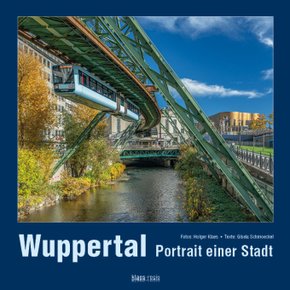| Verlag | Klaes-Regio Fotoverlag |
| Auflage | 2019 |
| Seiten | 172 |
| Format | 25,5 x 1,9 x 25,7 cm |
| Gewicht | 1200 g |
| ISBN-10 | 3965350285 |
| ISBN-13 | 9783965350281 |
| Bestell-Nr | 96535028A |
Wuppertal - Portrait einer Stadt Fotos Holger Klaes, Text Gisela SchmoeckelDer fotografische Streifzug zeigt die vielen Facetten der Schwebebahnstadt. Durch ihre Lage im Tal der Wupper und an den teils sehr steilen Hängen des Mittelgebirges reihen sich von Ost nach West große und kleinere Stadtteile aneinander, die sich individuell entwickelt haben. Schon vor dem Zusammenschluss von Barmen und Elberfeld im Jahr 1929 zur Großstadt Wuppertal ließ bürgerlicher Sinn für Technik und Handel das weltberühmte Pionierprojekt Schwebebahn entstehen. Fabriken liegen bis heute an den Ufern der Wupper, die im 18. Jahrhundert noch durch eine liebliche Auenlandschaft floss. Rasanter Einwohnerzuwachs sorgte für erhebliche soziale Probleme im 19. Jahrhundert. Die Entwicklung von der weltweit führenden Textilstadt mit führenden Unternehmen im Maschinenbau und chemischer Industrie sowie ihren typischen Gründerzeit-Wohnvierteln ist trotz der erheblichen Zerstörungen im Zweiten Weltkrieg im Stadtbild noch sichtbar. Bürgerliche Initiativen für den Denkmalschutz rettete seit den 1970er Jahren viel alte Bausubstanz. Große Veränderungen erfuhr das Zentrum Elberfelds zwischen Bahnhof und City seit dem Jahr 2000. Die 1974 gegründete Gesamthochschule, heute Bergische Universität gab der Stadt ein neues, von Wissenschaft, Design und Medienberufen geprägtes Gesicht. Ohne die vielfältige, oft hartnäckige private Initiative ist das Leben der Stadt nicht denkbar. So entstanden der 13 Kilometer lange Fahrradweg der Nordbahntrasse auf früherer Eisenbahnstrecke im Norden und die erfolgreiche, beliebte "Junior-Universität". Das Porträt-Buch zeigt eine dynamische Stadt im steten Wandel.
Bildband, 25 x 25 cm, 172 Seiten, 160 z.T. großformatigen Aufnahmen, zweisprachig DE/GB, Fadenheftung, 170 g/cm² Bilderdruck matt, Hardcover mit Schutzumschlag, einzeln eingeschweißt
Wuppertal - Portrait of a CityThe photographic foray shows the many facets of the suspension railway city. Large and small districts that have developed individually are strung together from east to west due to their location in the valley of the Wupper and on the sometimes very steep slopes of the relatively low mountain range. The bourgeois sense of technology and trade created the world famous pioneering project of the suspension railway even before the merger of Barmen and Elberfeld into the city of Wuppertal in 1929. Factories are still located on the banks of the Wupper which flowed through a lovely meadow landscape in the 18th century. Rapid population growth caused considerable social problems in the 19th century. The development of the world's leading textile city with leading companies in the mechanical engineering and chemical industries as well as the typical Wilhelminian neighbourhoods are still visible in the cityscape despite considerable destructions in the Second World War. Civil initiatives for the preservation of monuments have saved a lot of old buildings since the 1970s. The centre of Elberfeld between the train station and the city has undergone major changes since the year 2000. The Comprehensive University which was founded in 1974 and is now the Bergisch University gave the city a new face, shaped by science, design and media professions. The life of the city is inconceivable without diverse, often obstinate, private initiative. This is how the 13 kilometre cycle path of the Nordbahntrasse on the former railway line in the north and the successful, popular "Junior University" were built. This portrait book shows a dynamic city in a constant state of flux.

